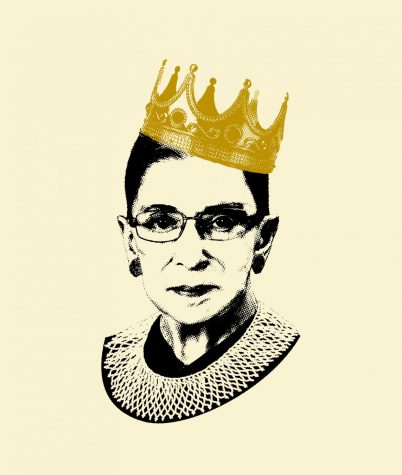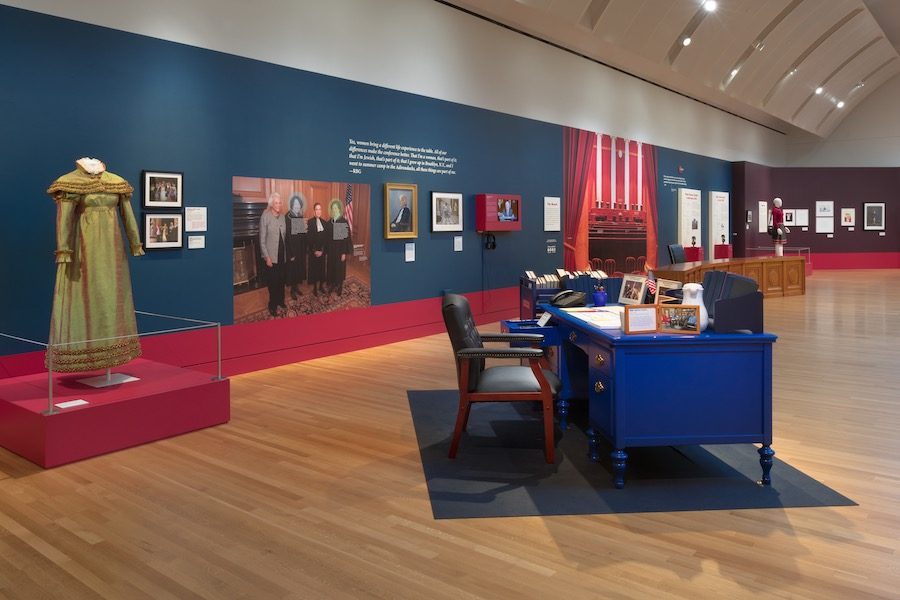Not just her initials: Skirball exhibit explains why RBG is ‘notorious’
MODELS: The exhibit uses recreations of important objects from GInsburg’s life to illustrate the moments that turned Ginsburg into the icon she is now. Photo by Robert Wedemeyer
March 5, 2019
When considering the achievements of history’s greatest social reformers, it’s easy to say that they were simply destined to achieve greatness and change society. This is true as well for Supreme Court Justice Ruth Bader Ginsburg, known for her monumental achievements for gender equality and women’s rights. More recently, she has gained cultural fame and been dubbed “the notorious RBG,” in the tradition of hip-hop legend The Notorious B.I.G, also known as Biggie Smalls. While it is partially a play on the fact she is commonly known simply by her three-letter initials, both RBG and Biggie pioneered new directions of their respective fields.
But the current exhibit at the Skirball Cultural Center, Notorious RBG: The Life and Times of Ruth Bader Ginsburg, is neither a simple account of her life nor a list of her legal accomplishments. Instead, it balances moments in her life that inspired her to become a legal activist for others with the specific cases which made her the icon she is today.

Photo from skirball.org
The centerpiece of the exhibit is a collage mural composed of a collection of drawings, memes, tweets, and protest signs all inspired by the now very famous Justice Ginsburg. This mural bisects the exhibit. Defining the individual sections are songs and lyrics from Biggie written on the wall, emphasizing the connection between the two cultural heroes.
On the left, labeled after Biggie’s song “I Got A Story To Tell,” the viewer is taken back 80 years to the humble living room of Ginsburg’s childhood apartment in Brooklyn, New York.
A recreation of the room is filled with objects that give the visitor a sense of what Ginsburg’s childhood was like, enriched with information panels that detail hardships she endured, including having watched her older sister die of meningitis.
This format of presenting scenes from Ginsburg’s life continues throughout this half of the exhibit, depicting Ginsburg’s marriage to her husband Martin, her time working at a Social Security office in Oklahoma and her years at Harvard Law School as one of only nine women in a class of over 500.
The visitor will recognize that from a young age, Ginsburg recognized issues of sexism and discrimination around her.
For example, at one time, Ginsburg noticed that female postage workers were forced to wear a hat that did not display their badge, while male workers’ hats did display it, giving them a more official or authoritative look. She wrote a letter to the postmaster general, which is displayed in the exhibit.
Another section of the exhibit is dedicated to civil rights activist Pauli Murray, whose legal opinions provided inspiration for Ginsburg. Letters from their correspondence are on view.
Each section of the exhibit gives viewers the sense that of having access to important moments and tactile elements of her life. Visitors also can sit in a recreation of the blue car the Ginsburgs drove, see her childhood books and look at a replica of the nameplate on her desk — all of these bridging the distance between the famous jurist who’s so well known and the Los Angeles visitor who will likely never meet her at all.
Over time, through her experiences, the future Justice Ginsburg became more and more upset about the difference in the treatment of women in American laws. In Oklahoma, she was demoted after becoming pregnant with her first child. After graduating from Columbia near the top of her class, she found it especially hard to get a job and was refused a clerkship under Supreme Court Justice Felix Frankfurter explicitly because of her gender.
The other side of the exhibit, to the right of the mural, presents the most important cases of Ms. Ginsburg’s career as an activist lawyer. Labeled “Stereotypes Of A Lady Misunderstood” — referencing Biggie’s song “Stereotypes of a Black Male Misunderstood” — the cases are arranged on tall displays with background information and artifacts under large-font quotes from her arguments or opinions. Among them are Frontiero vs Richardson, where she argued that military benefits should be given out regardless of sex, and Struck vs Secretary of Defense, where she successfully argued that female military officers should not be discharged for being pregnant.
As the personal artifacts elsewhere in the exhibit bring to life 40 years of Ginsburg’s personal history, the bullet-pointed outlines of the cases help the viewer understand the specifics of Ginsburg’s accomplishments.
Finally, the exhibit depicts Ginsburg’s career as a Supreme Court justice — labeled with Biggie’s song “My Team Supreme.” These include some famous cases she lost, among them Bush v. Gore, the case determining the constitutionality of a presidential recount in Florida, which decided the fate of the 2000 presidential election; and Shelby County v. Holder, determining whether states could alter their voting laws. Justice Ginsburg’s stinging dissents — displayed in large font on the exhibit walls here — for the 5-4 minority opinion helped earn her the Notorious epithet.
Also outlined is Ledbetter v. Goodyear Tire & Rubber Company, about gender pay discrimination which, before the case, were not able to be launched if the incident occured over 180 days prior. Ginsburg’s oral dissent argued that pay discrimination often occurs in very small increments over long periods of time and therefore it was often impossible to prove discrimination within 180 days. This dissent inspired Congressional Democrats to create the “Lilly Ledbetter Fair Pay Act of 2009,” allowing the admission of evidence from more than 180 days prior to a claim being filed.
After walking through the journey of Ms. Ginsburg’s life and the great and well-noted progress for which she’s been responsible, near the exit a visitor can try on a replica of her judicial robe — available in various sizes — and her signature collar, and sit at a replica of her desk. The point seems to be that anyone can make an impact in his or her world by recognizing injustices they encounter and taking action — whether or not it makes them notorious.
Notorious RBG: The Life and Times of Ruth Bader Ginsburg can be seen at the Skirball Cultural Center on Mulholland Drive in Bel Air through March 10. The exhibit is free with general admission to the museum, which costs $12.
Get the latest from The Boiling Point. Sign up for our news feed.














